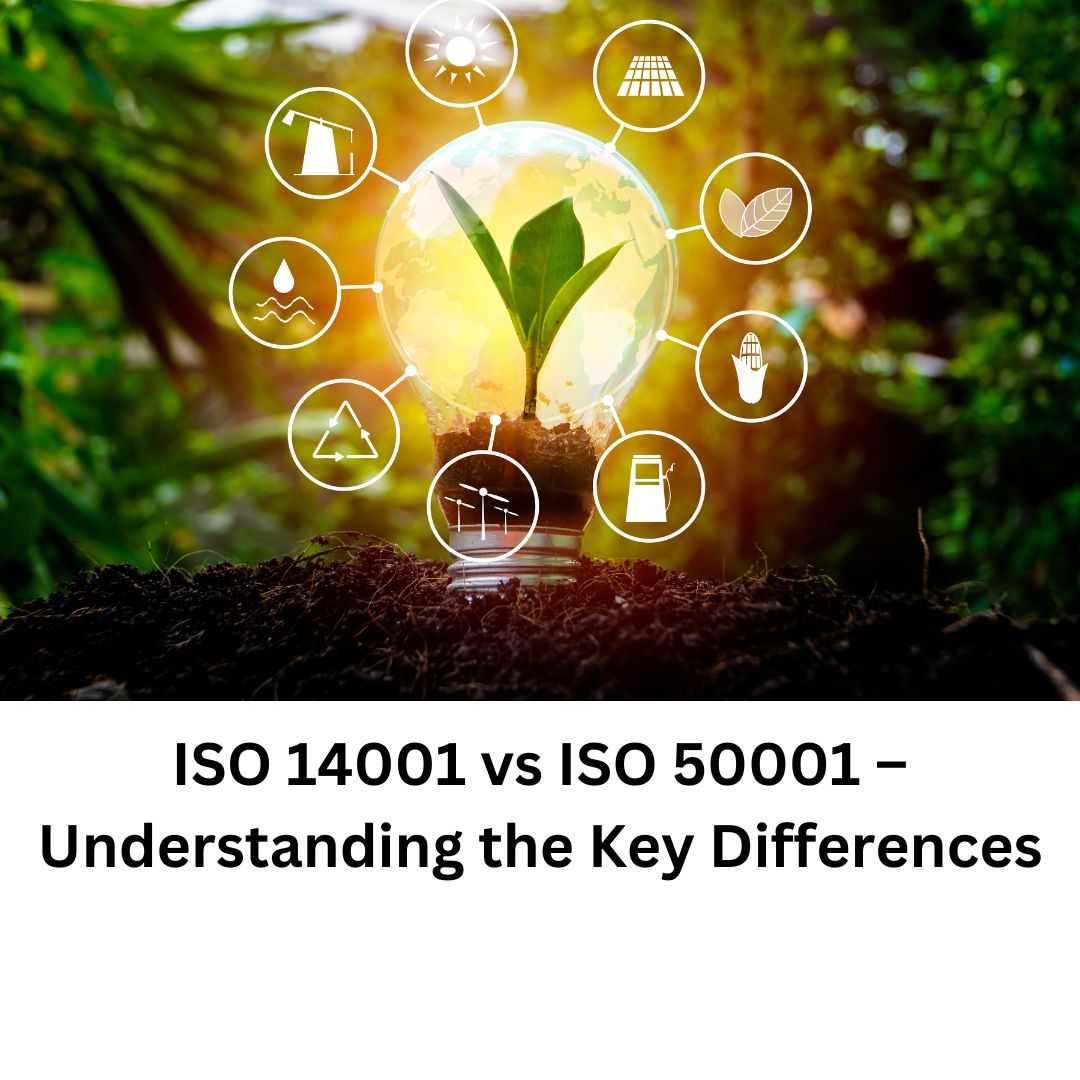Blog Details

ISO 14001 vs ISO 50001 – Understanding the Key Differences
In today’s business world, sustainability and resource management are no longer optional—they are essential. Organizations across industries are under increasing pressure to demonstrate environmental responsibility, reduce energy consumption, and comply with regulatory frameworks.
Two of the most recognized international standards in this space are ISO 14001 (Environmental Management System) and ISO 50001 (Energy Management System). While both standards promote sustainability and efficiency, they focus on different aspects of organizational performance.
This article explores ISO 14001 and ISO 50001 in detail, highlighting their objectives, benefits, similarities, and differences, and helps guide organizations on choosing the right standard—or even combining them for maximum impact.
🌿 What is ISO 14001?
ISO 14001 is an internationally recognized standard for Environmental Management Systems (EMS). It provides a framework for organizations to identify, manage, monitor, and reduce their environmental impact.
- ♻️ Manage environmental aspects such as waste, emissions, water use, and pollution.
- ⚠️ Reduce environmental risks and ensure compliance with regulations.
- 📈 Foster continual improvement in environmental performance.
- 🌱 Enhance corporate reputation by showcasing commitment to sustainability.
ISO 14001:2015 follows the High-Level Structure (Annex SL), making it easier to integrate with other ISO management system standards.
🔌 What is ISO 50001?
ISO 50001 is the international standard for Energy Management Systems (EnMS). It provides a structured approach to improve energy efficiency, reduce consumption, and lower costs.
- 💡 Improve energy efficiency and reduce energy consumption.
- 💰 Lower energy costs while maintaining productivity.
- 🌍 Decrease greenhouse gas emissions by reducing fossil fuel use.
- 🏭 Promote a culture of energy-conscious practices within organizations.
ISO 50001:2018 also uses the Annex SL structure, enabling easy integration with ISO 14001 and other ISO standards.
🔗 Similarities Between ISO 14001 and ISO 50001
- 📋 Annex SL Structure: Shared management system framework (context, leadership, planning, etc.).
- 🔁 Continuous Improvement: Both follow the Plan-Do-Check-Act (PDCA) cycle.
- 🌐 Global Applicability: Suitable for any organization, regardless of industry or size.
- ⚖️ Regulatory Support: Help organizations meet legal and compliance obligations.
- 🔄 Integration Possibility: Can be implemented individually or as part of an integrated system.
⚖️ Differences Between ISO 14001 and ISO 50001
- 📌 Scope and Focus:
ISO 14001: Covers all environmental aspects (waste, pollution, water, etc.).
ISO 50001: Focuses solely on energy use and efficiency. - 🎯 Primary Goal:
ISO 14001: Minimize environmental footprint.
ISO 50001: Optimize energy performance. - 📊 Performance Indicators:
ISO 14001: Environmental Performance Indicators (e.g., CO₂ emissions, water use).
ISO 50001: Energy Performance Indicators (e.g., kWh/unit produced). - 🔍 Drivers of Implementation:
ISO 14001: Driven by environmental regulation and stakeholder pressure.
ISO 50001: Driven by energy costs, efficiency, and climate goals. - 🏗️ Industry Relevance:
ISO 14001: Broadly applicable across all industries.
ISO 50001: Especially relevant for energy-intensive sectors. - 📏 Impact Measurement:
ISO 14001: Broader environmental impacts.
ISO 50001: Specific to energy usage and efficiency. - 🎁 Certification Benefits:
ISO 14001: Builds trust and enhances brand through environmental stewardship.
ISO 50001: Delivers tangible cost savings and energy benefits.
🌟 Key Benefits of Each Standard
✅ Benefits of ISO 14001:
- 🚯 Helps control pollution and manage waste.
- 🧩 Reduces non-compliance risks.
- 💚 Builds brand reputation among eco-conscious consumers.
- 🔐 Improves environmental risk management.
✅ Benefits of ISO 50001:
- 💵 Cuts energy bills and operational costs.
- 🌡️ Aligns with climate change and decarbonization goals.
- 🧠 Encourages innovative energy-saving practices.
- 📉 Reduces dependency on volatile energy markets.
🤔 Which Standard Should You Choose?
- 🌳 Choose ISO 14001 if your priority is reducing overall environmental impact.
- ⚡ Choose ISO 50001 if your focus is on cutting energy consumption and improving efficiency.
- 🔗 Consider both for a fully integrated sustainability strategy that covers environment and energy.
🛠️ ISO 14001 + ISO 50001 – A Combined Approach
Implementing both standards together delivers a powerful dual benefit:
- 💡 Reduce environmental footprint and energy costs simultaneously.
- 📜 Meet a wider range of legal and regulatory expectations.
- 🏆 Position your brand as a sustainability leader.
- 🌍 Align with ESG and Sustainable Development Goals (SDGs).
For instance, a manufacturing company can reduce emissions with ISO 14001 and optimize energy use with ISO 50001—leading to improved efficiency, reduced costs, and a stronger market position.
📌 Conclusion
Both ISO 14001 and ISO 50001 are vital tools in an organization’s sustainability toolkit. Choosing the right one—or combining both—depends on your strategic goals.
By implementing these standards, businesses not only comply with regulations but also position themselves for long-term environmental and economic success in an increasingly eco-conscious marketplace.
Leave a Comment
We would love to hear your thoughts! Please leave your comment below:
